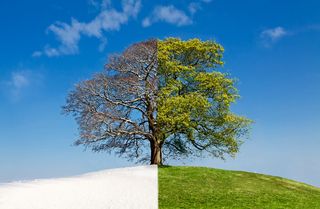Depression
Light Therapy Can Help Treat Depression Year-Round
Bright light therapy can help treat both seasonal and nonseasonal depression.
Posted November 19, 2015

In "Blinded by the Light," Bruce Springsteen sings, "Mama always told me not to look into the sights of the sun. But Mama, that's where the fun is." In many ways, Springsteen is right. A new study reports that staring into an artificial source of bright light for 30 minutes every morning for eight weeks helped people with major depressive disorder (MDD) feel better.
Traditionally, bright light therapy has been considered a treatment for seasonal depression also known as Seasonal Affective Disorder (SAD). Until now, there has been limited evidence about the efficacy of light treatment as a way to reduce symptoms in those with nonseasonal depression. Recently, researchers in Canada reported that light therapy can, in fact, treat nonseasonal depression and improve the overall well-being of people suffering from clinical depression.
Bright Light Therapy Can Help Treat Depression Year-Round
According to the Canadian researchers, depression affects one in 20 people around the world. Depression is among the leading causes of disability globally. Although medications can be effective for treating depression, the researchers state that antidepressants, such as Prozac, only work for about 60% of the population.
The November 2015 study, “Efficacy of Bright Light Treatment, Fluoxetine, and the Combination in Patients With Nonseasonal Major Depressive Disorder,” was published online in the journal JAMA Psychiatry.
During the course of the five-year study, Dr. Raymond Lam and his colleagues from the Department of Psychiatry at the University of British Columbia (UBC) and Vancouver Coastal Health Research Institute evaluated whether using a 10 000-lux fluorescent white light therapy improved the mood of depressed patients.
In this study, the researchers tested light therapy by itself and with or without the commonly prescribed antidepressant fluoxetine, which is sold under the brand name Prozac. In a press release, Lam said:
"These results are very exciting because light therapy is inexpensive, easy to access and use, and comes with few side effects. It's important to find new treatments because our current therapies don't work for everyone. Patients can easily use light therapy along with other treatments such as antidepressants and psychotherapy. Our findings should help to improve the lives of people with depression.”
For this study, the light therapy involved 30 minutes of exposure to a light box soon after waking up every day for eight weeks. Some study participants were given placebo pills as well as placebo devices instead of the real light therapies or Prozac tablets. The researchers found that 10,000-lux light therapy helped a wide range of patients. The greatest benefit was observed in those who used antidepressants in conjunction with light therapy.
Previous research has found that exposure to natural light year-round helps to maintian a healthy mind and body. If you work in a windowless environment, it's important to seek exposure to natural light on lunch breaks, etc. Exposure to natural light in small doses is good for your physical and psychological well-being on many levels.
The suprachiasmatic nucleus (SCN) relies on light exposure to stay synchronized with our environments and to regulate our circadian rhythms which affect the 24-hour cyclical function of every cell in the human body. Sunlight also facilitates Vitamin D production. Please use common sense in terms of protecting your eyes and skin from UVA/UVB exposure and sun damage.
Conclusion: Let the Sun Shine In!
Like millions of people, I have a tendency to get the winter blues. I’ve also had two MDD episodes in my life. As a personal testimonial, I can attest to the power of light therapy, psychotherapy, and lifestyle choices such as physical activity, pouring my heart into projects that I'm passionate about, and staying closely bonded with friends and family as tools for combating depression without the use of antidepressants.

Every winter, when the sun starts setting in the late afternoon, I know that I must stay vigilant about maintaining my mental and physical health. This includes using my Day-Light Classic 10,000 LUX Bright Light Therapy Lamp. Obviously, there are situations where using medication is necessary and extremely beneficial—especially when combined with other lifestyle choices and drug-free treatments such as light therapy.
I also use my light therapy session in the morning as a time to practice daily mindfulness meditation. Piggybacking a 30-minute session that combines light therapy and mindfulness meditation is a double whammy that helps keep my spirits buoyed in the wintertime. After reading this study, I'll be sure to use my light box year-round, if ever I feel a bout with a major depressive episode incubating.
Bright light therapy is an inexpensive non-pharmacological tool that people of all ages can use year-round to treat depression. If you are prone to seasonal or nonseasonal depression, the latest research indicates that using light therapy can be an effective drug-free treatment option. Light therapy can also be used in conjunction with medication, psychotherapy, and other lifestyle choices to help you avoid the winter doldrums and combat clinical depressive symptoms year-round.
If you'd like to read more on this topic, check out my Psychology Today blog posts,
- "How Does Your Circadian Clock Keep Track of the Seasons?"
- "Circadian Rhythms Linked to Aging and Well-Being"
- "Exposure to Natural Light Improves Workplace Performance"
- "Why Is a Camping Trip the Ultimate Insomnia Cure?"
- "Everyday Access to Nature Promotes Well-Being As We Age"
- "Maintaining Healthy Social Connections Improves Well-Being"
- "Revolutionary Ideas About the Science of Depression"
© 2015 Christopher Bergland. All rights reserved.
Follow me on Twitter @ckbergland for updates on The Athlete's Way blog posts.
The Athlete’s Way ® is a registered trademark of Christopher Bergland.




